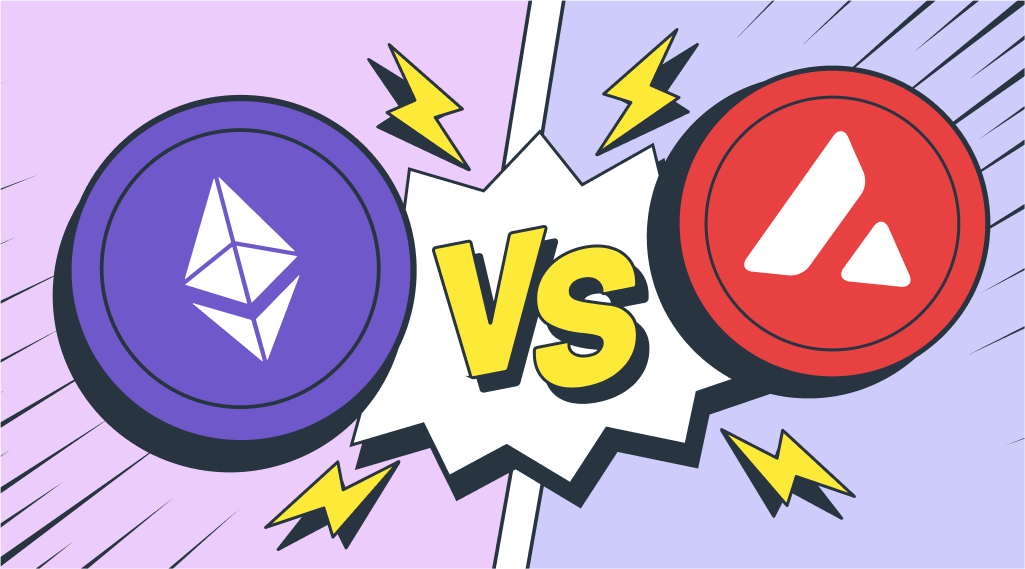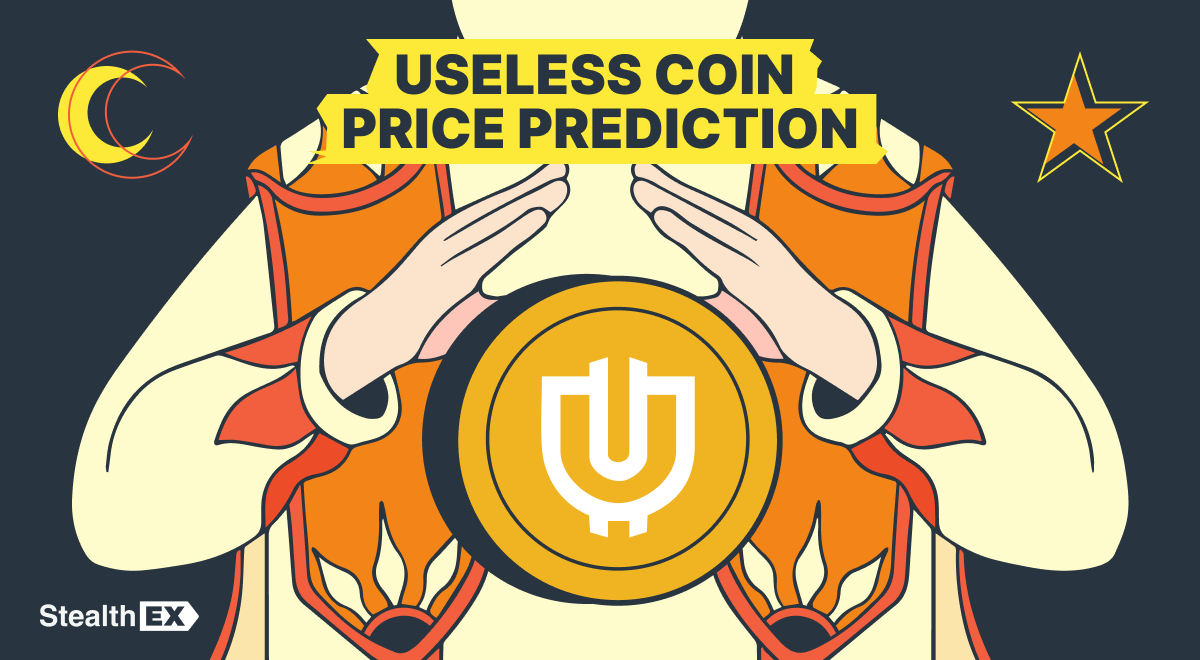Avalanche vs Ethereum — Which Is Better? AVAX and ETH Comparison

In the blockchain technology sector, two giants stand out: Avalanche and Ethereum. The debate over “Avalanche vs Ethereum” has been a hot topic among crypto enthusiasts and investors. Both platforms offer unique features and have their own set of advantages. But which one is truly better? In this article, we’ll go deep into the intricacies of both blockchains, comparing their strengths and weaknesses. First, let’s start by understanding what Avalanche (AVAX) and Ethereum (ETH) are individually.

Article contents
- 1 What Is Avalanche (AVAX)?
- 2 What Is Ethereum (ETH)?
- 3 Avalanche vs Ethereum – Key Differences Between AVAX and ETH
- 4 Avalanche vs Ethereum – Key Similarities Between AVAX and ETH
- 5 Avalanche vs Ethereum – Comparison Table
- 6 Summary
- 7 FAQ
- 7.1 What Is the Primary Difference Between Avalanche and Ethereum?
- 7.2 Is Avalanche Faster than Ethereum?
- 7.3 Can I Run Ethereum dApps on Avalanche?
- 7.4 Which Platform Has Lower Transaction Fees?
- 7.5 Are Both Platforms Secure?
- 7.6 Which Blockchain Has More dApps?
- 7.7 Can I Stake on Both Platforms?
- 7.8 Which Platform Is More Decentralized?
What Is Avalanche (AVAX)?
Avalanche is a decentralized platform designed to offer highly scalable and customizable blockchain networks. Unlike traditional blockchains that operate on a single, static chain, Avalanche employs a unique consensus protocol known as the Avalanche Consensus. It allows for the creation of multiple interoperable blockchains, enhancing scalability and efficiency.
AVAX, the native token of Avalanche, is used for transaction fees and as a staking mechanism to secure the network. With its emphasis on speed, low fees, and adaptability, Avalanche aims to be a go-to platform for decentralized applications (dApps) and custom blockchain networks.
What Is Ethereum (ETH)?
Ethereum, often called the pioneer of smart contract platforms, is a decentralized open-source blockchain system. Launched in 2015 by Vitalik Buterin and a team of developers, Ethereum introduced the concept of “smart contracts” – self-executing contracts with the terms of the agreement directly written into code. This innovation paved the way for decentralized applications (dApps) to be built on its platform.
ETH, Ethereum’s native cryptocurrency, is a medium of exchange and compensates participant nodes. With its robust developer community and rich ecosystem, Ethereum remains a dominant force in the blockchain space, driving innovation and adoption.
Avalanche vs Ethereum – Key Differences Between AVAX and ETH
Avalanche and Ethereum emerged as two powerful platforms, each with a vision and technical foundation. While both aim to revolutionize the way decentralized applications and smart contracts operate, their approaches differ in various aspects. These differences are not limited to technical specifications but also encompass their philosophies, community engagement, and long-term visions. By understanding these distinctions, users, developers, and investors can decide which platform aligns best with their objectives. Here are some of the key differences between Avalanche and Ethereum:
- Consensus Mechanism – Avalanche uses the Avalanche Consensus, a novel protocol that allows for rapid transaction finality and high throughput. Ethereum, on the other hand, use Proof-of-Stake (PoS).
- Scalability – Avalanche boasts of its ability to handle thousands of transactions per second (TPS) thanks to its unique architecture of multiple interoperable blockchains. Ethereum, while having scalability challenges in its current form, is working on solutions like sharding and layer 2 scaling to improve its TPS.
- Development Ecosystem – Ethereum has a more mature and extensive developer ecosystem, given its head start in the blockchain space. Avalanche, though newer, is gaining traction and building its developer community.
- Interoperability – Avalanche emphasizes its capability to create custom blockchains that can interoperate with each other. Ethereum primarily focuses on its main chain, with interoperability being achieved through bridging solutions.
- Native Token Utility – AVAX, Avalanche’s native token, is used for staking and transaction fees. ETH, Ethereum’s token, has a broader utility, including being used for gas fees, staking and as collateral in various DeFi platforms.
- Decentralized Applications (dApps) – Ethereum is home to many dApps, spanning various sectors like finance, gaming, and art. Avalanche, while having fewer dApps currently, is positioning itself as a viable alternative for developers looking for faster and cheaper platforms.
- Fees – Transaction fees on Ethereum, especially during network congestion, can be high. Avalanche, with its emphasis on low fees, offers a more predictable and affordable fee structure for users and developers.
- Adoption – Ethereum, being older, has a wider adoption and recognition in the crypto community. Avalanche, though newer, is making significant strides in partnerships and integrations.
In essence, while both blockchains have their strengths, the choice between Avalanche and Ethereum often boils down to specific use cases and individual preferences.
Choose StealthEX for Exchange and Buy Crypto
- User-Friendly — Simple and minimalistic interface for everyone.
- Fast and Private — Instant non-custodial cryptocurrency exchanges.
- Buy crypto with Credit Card.
- 1400+ coins and tokens are available for limitless, quick and easy exchanges.
- NO-KYC crypto exchanges — Buy cryptocurrency up to €700 without KYC!
- StealthEX crypto exchange app — Process crypto swaps at the best rates wherever you are.
- 24/7 Customer Support.
Earn from Each Exchange by Joining StealthEX Affiliate Program.
Become a partner right now and use affiliate tools:
- Public API — Earn from your wallet, aggregator, or exchange terminal.
- Referral Links — Recommend StealthEX to your audience.
- Exchange Widget — Built crypto exchange widget on any page of your website.
- Button — A perfect choice for traffic monetization.
- Banner — Track conversion and stats right in the personal cabinet.
Avalanche vs Ethereum – Key Similarities Between AVAX and ETH
Avalanche and Ethereum share a foundational ethos that drives the broader blockchain movement. Both platforms are born from a desire to harness the power of decentralization, enabling a new era of applications, financial systems, and trust mechanisms. They represent the vanguard of blockchain innovation, showcasing how technology can be leveraged to create more transparent, equitable, and efficient systems. While they chart their paths, there are underlying parallels that bind them together in their quest to reshape the digital sector. Here are some of the key similarities between Avalanche and Ethereum:
- Decentralization – Both platforms prioritize decentralization, ensuring no single entity controls the network. This decentralization is fundamental to their security, trustworthiness, and resilience against censorship.
- Smart Contracts – Both Avalanche and Ethereum support the development and execution of smart contracts. These self-executing contracts enable automation and trustless interactions on the blockchain.
- Open-Source – Both projects are open-source, allowing developers worldwide to contribute, audit, and build upon their codebases. This openness fosters innovation and community engagement.
- Native Tokens – Both blockchains have native tokens (AVAX for Avalanche and ETH for Ethereum) essential for network operations, from paying transaction fees to staking and securing the network.
- dApps Platform – Both Avalanche and Ethereum serve as platforms for decentralized applications (dApps). Developers can build various applications, from DeFi to gaming, on both networks.
- Community-Driven – Both projects have strong, active communities that drive development, adoption, and advocacy. These communities play a crucial role in the evolution and success of both platforms.
- Focus on Interoperability – While their approaches may differ, both Avalanche and Ethereum recognize the importance of interoperability in the blockchain space. They aim to ensure their platforms can communicate and collaborate with other blockchains and systems.
- Security – Security is a top priority for both Avalanche and Ethereum. They employ various mechanisms, from consensus protocols to cryptographic techniques, to ensure the safety and integrity of their networks.
In essence, while they may have their unique features and strengths, both Avalanche and Ethereum share a common vision of a decentralized, open, and interconnected blockchain ecosystem.
Avalanche vs Ethereum – Comparison Table
| Feature | Avalanche (AVAX) | Ethereum (ETH) |
| Consensus Mechanism | Avalanche Consensus | Proof-of-Stake |
| Scalability | High (thousands of tps) | Moderate (working on scalability solutions) |
| Development Ecosystem | Growing rapidly | Mature and extensive |
| Interoperability | Multiple interoperable blockchains | Bridging solutions for interoperability |
| Native Token Utility | Staking, transaction fees | Gas fees, staking, collateral in DeFi |
| dApps | Growing number | Vast number across various sectors |
| Fees | Predictable and often lower | Can be high during network congestion |
| Adoption | Gaining traction | Widely adopted and recognized |
Summary
Avalanche and Ethereum, two titans in the blockchain arena, offer distinct solutions to the challenges of decentralization, scalability, and interoperability. While Ethereum, with its pioneering smart contract capabilities, has firmly established itself as a leader in the space, Avalanche brings to the table a unique consensus mechanism and a vision of multiple interoperable blockchains. Both platforms, however, are committed to open-source development, community engagement, and the transformative potential of blockchain technology. Whether one chooses Ethereum for its rich ecosystem and history or Avalanche for its scalability and adaptability, it’s evident that both blockchains play a pivotal role in shaping the future of decentralized applications and systems.
FAQ
What Is the Primary Difference Between Avalanche and Ethereum?
While both are platforms for decentralized applications and smart contracts, Avalanche uses the Avalanche Consensus for rapid transaction finality and scalability. In contrast, Ethereum use proof of stake but plan to implement sharding.
Is Avalanche Faster than Ethereum?
Yes, Avalanche boasts the ability to handle thousands of transactions per second, making it faster in terms of throughput than the’s current version of Ethereum.
Can I Run Ethereum dApps on Avalanche?
With certain modifications and bridging solutions, developers can port and run Ethereum dApps on Avalanche.
Which Platform Has Lower Transaction Fees?
Avalanche generally offers more predictable and often lower transaction fees, especially when compared to Ethereum during network congestion.
Are Both Platforms Secure?
Both Avalanche and Ethereum prioritize security and employ various mechanisms to ensure the safety and integrity of their networks.
Which Blockchain Has More dApps?
Ethereum, being older and more established, currently has a larger number of dApps. However, Avalanche is quickly growing its dApp ecosystem.
Can I Stake on Both Platforms?
Yes, both platforms offer staking mechanisms. AVAX is used for staking on Avalanche, while Ethereum introduces staking with its Ethereum 2.0 upgrade.
Which Platform Is More Decentralized?
Both platforms prioritize decentralization, ensuring no single entity has undue control. The level of decentralization can vary based on network participants and validators.
Follow us on Medium, Twitter, Telegram, YouTube, and Publish0x to stay updated about the latest news on StealthEX.io and the rest of the crypto world.
This article is not supposed to provide financial advice. Digital assets are risky. Be sure to do your own research and consult your financial advisor before investing.
Avalanche AVAX crypto world ETH EthereumRecent Articles on Cryptocurrency
 Useless Coin Price Prediction: Is USELESS Crypto a Good Investment?
Useless Coin Price Prediction: Is USELESS Crypto a Good Investment?  OFFICIAL TRUMP Coin Price Prediction: How High Will TRUMP Crypto Go?
OFFICIAL TRUMP Coin Price Prediction: How High Will TRUMP Crypto Go? 